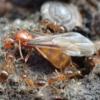Recently, my brother ("Bracchymyrmex"), and I have been documenting the species in your backyard, or the general vicinity of our neighborhood, to anticipate nuptial flights. So far we've set out bait traps, lifted up logs and simply explored to find different colonies. In this thread, I'll post pictures & statuses of some of the ants I find in my area, and add them to a general census I'll include in this post. Later on, when I get a bit more organized, I'll design a little map so I can match each colony to a general area. For now, I'll list the species name, and a little information about where they're nesting and what I've witnessed in terms of foraging.
I would say the purpose of this thread is to keep track of all the colonies we know exist in out area, and for you all to voice your opinions, or provide some helpful information about the ants listed. For example, if one of the species listed was Crematogaster cerasi, one of you could tell me they were called "Acrobat Ants" and they triangular gasters. Or, if I clearly needed help deciphering between Formica and Camponotus workers, someone could give me a little help with that.
I suspect this will be slightly more useful to people who live relatively near where I do, so I've specified "Mid-Atlantic" and "North East" regions in the title.
Without further ado, here are some of the species that Bracc. and I have documented in Philadelphia. Red species live directly in my backyard, purple species live in my neighborhood and blue species are in Philadelphia, but are not in my general vicinity:
- Brachymyrex depilis - Caught a queen during mid-flight on my driveway.
- Myrmica sp. - Caught several queens after a flight, and have located a colony across from my garage.
- Tapinoma sessile - At this time of year, nearly all the ants foraging near my house are Tapinoma. There are several colonies in my yard.
- Tetramorium caespitum - Not sure if Sp. E or caespitum, but I really don't care that much. These are as, if not more, abundant than Tapinoma.
- Camponotus pennsylvanicus - Always been in my yard, Bracc. caught a dealate queen while taking our dog for a walk last summer.
- Camponotus chromaiodes - Either C. chromaiodes or C. novaeboracensis, but most likey C. chromaiodes.
- Camponotus castaneus - could also be a lighter Formica sp. I saw her during fall of last year, and only vaguely remember her appearance.
- Formica subsericea - Used to think was C. pennsylvanicus, locate a few workers foraging on a path outside.
- Formica pallidefulva - Thought they were C. chromaiodes first, but then Milta knocked some sense into me.
- Lasius neoniger - Located near where the F. pallidefulva live- very active during the day.
- Lasius alienus - Have a colony right outside my house, and live under two plastic sheets. I've put some stone near their nest, hopefully they move in.
- Laisus flavus - Briefly caught a glimpse of a worker while anting, she dashed right into her hole. She may also be a worker of a parasitic Lasius species.
- Monomorium minimum - So cute. Just way too cute. They also really love honey.
- Nyladneria faisonensis - Had a colony in our backyard, but we scooped the whole thing up and they're thriving in captivity
- Solenopsis molesta - Seem to have made very good friends with the L. neoniger...
- Nylanderia terricola - Located a nest at our school, just waiting for them to fly.
- Pheidole sp. - Could be P. bicarnata or P. pilifera, will have to create an ID thread.
- Prenolepis imparis - Caught 16 queens during a flight earlier this month.
- Crematogaster cerasi - caught several queens during a flight last September
- Vollenhovia emeryi - Fort Washing State Park
- Temnothorax curvispinosus - Fort Washington State Park
And that's pretty much it. Feel free to leave any questions or comments, thank you!
Edited by VoidElecent, April 23 2017 - 5:55 PM.


















